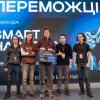Feed aggregator
SMART launches interdisciplinary research group WISDOM to develop 3D sensing technologies
🌺 Краса японського мистецтва ошібана тепер і в нашому університеті!
В Українсько-Японському центрі КПІ ім. Ігоря Сікорського відкрилася авторська виставка робіт «Закохані в ошібану» — стародавнє мистецтво самураїв, які між битвами знаходили спокій у єднанні з природою, збираючи квіти й створюючи витончені композиції.
КПІшники — переможці змаганнь з кібербезпеки MITIT CTF 2025!
🏆 Команда Навчально-наукового фізико-технічного інституту (НН ФТІ) стала найкращою серед команд вітчизняних і міжнародних військових і цивільних закладів вищої освіти у MITIT CTF 2025, які відбулися у межах III Міжнародної науково-практичної конференції «Кіберборотьба: розвідка, захист та протиді
День пам’яті та перемоги над нацизмом у Другій світовій війні 1939–1945 років
У ці травневі дні вся Україна разом зі світовою спільнотою вшановує пам’ять загиблих у Другій світовій війні — мільйонів людей, які віддали своє життя в боротьбі з нацизмом.
Skyworks appoints Mark Dentinger as CFO and Todd Lepinski as senior VP, sales & marketing
imec and TNO launch Holst Centre Photonics Lab
Indium Corp extracts gallium from feed sourced at Rio Tinto’s Quebec aluminium operation
Converting square-waves into saw-teeth

Generating analog sawtooth waveforms (linear ramp followed by a quick reset to zero) from digital timing signals is a common function. It usually requires a negative supply as sketched in Figure 1, where Vsaw = -(-V) Tsq/(R1C1).
 Figure 1 The usual topology for converting digital square waves to analog sawtooth requires a negative rail.
Figure 1 The usual topology for converting digital square waves to analog sawtooth requires a negative rail.
Wow the engineering world with your unique design: Design Ideas Submission Guide
Negative current through R1 ramps up inverting integrator A1’s output until switch U1 resets it to zero. This topology is simple and works well, but it has the disadvantage of needing a separate negative rail so the integrator can be referenced to ground. Also, the RC network in front of U1, which needs to differentiate the positive edge of the square wave, is kind of messy and less than precise.
Figure 2 shows an alternative sawtooth topology that employs flying capacitor C2 to reset A1. This allows it to be referenced to the positive rail instead of ground, eliminating the need for Figure 1’s negative rail and pulse differentiation. Here’s how it works.

Figure 2 Flying capacitor C2 resets the RRIO ramp to zero volts, allowing it to be referenced to the positive rail instead of ground.
RRIO op-amp A1’s positive input being tied to the VL positive rail allows R1 to act as a current sink between ground and A1’s summing point. This ramps A1’s output positively to:
Vsaw = VL Tsq / (R1C1)
Simultaneously, flying capacitor C2 charges to Vsaw via its connection to A1’s output through U1a. Then, on the positive-going edge of “Square In,” the bottom end of C2 is connected to A1 summing point while its top end switches from ground to VL. This dumps a quantum of charge into C1:
(VL + (Vsaw – VL))C2 = VsawC2
Given that C1 = C2, this resets “Saw Out” to ground as shown in Figure 3.

Figure 3 “Square In” and “Saw Out” voltage waveforms where Vsaw = VL T/(R1C1).
For best accuracy, R1, C1 and C2 should be precision types.
Stephen Woodward’s relationship with EDN’s DI column goes back quite a long way. Over 100 submissions have been accepted since his first contribution back in 1974.
Related Content
- Dual RRIO op amp makes buffered and adjustable triangles and square waves
- DAC (PWM) Controlled Triangle/Sawtooth Generator
- Voltage-controlled triangle wave generator
- 555 triangle generator with adjustable frequency, waveshape, and amplitude; and more!
- Adjustable triangle/sawtooth wave generator using 555 timer
- Squashed triangles: sines, but with teeth?
- Sawtooth Generator Circuit with 741 IC
The post Converting square-waves into saw-teeth appeared first on EDN.
📰 Газета "Київський політехнік" № 19-20 за 2025 (.pdf)
Вийшов 19-20 номер газети "Київський політехнік" за 2025 рік
onsemi’s AR0145CS Hyperlux SG Image Sensors, Now at Mouser, Accurately Capture Moving Scenes
Mouser Electronics, Inc., the authorised global distributor with the newest electronic components and industrial automation products, is now stocking the AR0145CS Hyperlux SG image sensors from onsemi. The AR0145CS is a 1/4.3 inch CMOS digital image sensor with a 1280 (H) x 800 (V) active-pixel array. Capturing both continuous video and single frames, the AR0145CS sensors are ideal for scanning and industrial inspection applications.
The onsemi AR0145CS Hyperlux SG image sensors, now available at Mouser, offer sophisticated camera features, including auto exposure control, pixel binning, row- and column-skip modes, and windowing. An innovative global shutter pixel design allows the sensors to capture moving scenes with speed and accuracy.
The AR0145CS image sensors include automatic black level calibration (ABLC) and produce clear, low-noise images in low-light and bright scenes. The sensors are programmable through a simple, two-wire interface and include an on-chip trigger mode for synchronization, built-in flash control, and two on-chip phase lock loops (PLLs). With this combination of features, the AR0145CS Hyperlux SG image sensors are suitable for a wide range of applications, including bar code scanners, gesture recognition, augmented reality, biometrics, surveillance, HD video, and machine vision.
As a global authorized distributor, Mouser offers the widest selection of the newest semiconductors, electronic components and industrial automation products. Mouser’s customers can expect 100% certified, genuine products that are fully traceable from each of its manufacturer partners. To help speed customers’ designs, Mouser’s website hosts an extensive library of technical resources, including a Technical Resource Center, along with product data sheets, supplier-specific reference designs, application notes, technical design information, engineering tools and other helpful information.
Engineers can stay abreast of today’s exciting product, technology and application news through Mouser’s complimentary e-newsletter. Mouser’s email news and reference subscriptions are customizable to the unique and changing project needs of customers and subscribers. No other distributor gives engineers this much customization and control over the information they receive.
The post onsemi’s AR0145CS Hyperlux SG Image Sensors, Now at Mouser, Accurately Capture Moving Scenes appeared first on ELE Times.
NOR flash memory certified for ASIL-D functional safety

A NOR flash memory serving advanced driver assistant systems (ADAS), zone control, gateway, and digital cockpit designs has achieved ASIL-D functional safety certification from SGS-TÜV, a testing, inspection, analysis, and certification services specialist. External experts from this assurance organization validated Infineon’s SEMPER NOR flash memory for the most stringent safety performance in automotive applications after a detailed analysis of product safety documentation under the ISO 26262:2018 standard.
Infineon also claims that its SEMPER NOR flash is the first memory product developed in compliance with the ISO26262 functional safety standard. “We are proud that the experts at SGS-TÜV have certified our achievements in functional safety and invite our customers to design SEMPER NOR products into their most demanding applications,” said Rainer Hoehler, senior VP and general manager of memory solutions at Infineon.

OEMs and regulators demand the highest levels of safety in automotive designs, from battery management to ADAS to autonomous driving. Source: Infineon
According to Infineon, the ASIL-D certification applies to the full range of SEMPER NOR memory products. That includes HYPERBUS and JEDEC xSPI octal interfaces as well as 256-megabit to 2-gigabit densities. Moreover, these memory products are qualified to AEC-Q100 grade 1 standard.
More information about NOR flash memory and its ASIL-D functional safety certification is available on Infineon’s Memory Solutions Hub web portal. The company also offers the “SEMPER SDK Safe” software development package alongside this NOR flash memory.
Related Content
- The Shift from 2D to 3D NOR Flash
- Flash 101: NAND Flash vs NOR Flash
- Flash 101: The NOR Flash electrical interface
- NOR flash eyes IoT devices catering to more code, data
- Improving performance using SPI-DDR NOR flash memory
The post NOR flash memory certified for ASIL-D functional safety appeared first on EDN.
KYOCERA AVX Launches New CP2816 Series High-Directivity Couplers
The new rugged, compact, and low-profile CP2816 Series integrated thin film (ITF) directional couplers satisfy cross-market demand for small, high-power couplers compatible with VHF and UHF bands.
KYOCERA AVX,a leading global manufacturer of advanced electronic components engineered to accelerate technological innovation and build a better future, released the new CP2816 Series integrated thin film high-directivity couplers for high-frequency wireless systems.
Developed in response to customer requests for small, high-power couplers compatible with very- and ultra-high-frequency bands, the new CP2816 Series ITF high-directivity couplers feature a rugged, compact, and low-profile 2816 (7x4mm) case and exhibit 20W continuous power handling, 50Ω impedance, and excellent high-frequency performance from 225–750MHz and -40°C to +105°C. They also exhibit a tight coupling factor over the frequency range (-10±1.2dB, -10±2dB, -15±2dB, and -15±4dB), low insertion loss extending from less than -0.8dB to less than -0.9dB, a voltage standing wave ratio of 1.3, and -14dB directivity. Additional benefits include high temperature stability, high lot-to-lot and part-to-part reliability, and repeatable RF performance.
The new CP2816 Series ITF high-directivity couplers also enable quick adjustments to RF parameters and are ideal for use in high-frequency wireless applications extending throughout the telecommunications, commercial aerospace, military and defense, and automotive markets, including active antennas, base stations, emergency systems, mobile tactical radios, VHF and UHF radios, radar systems, and test equipment.
“Our new CP2816 Series integrated thin film high-directivity couplers satisfy growing market demand for small, high-power components optimized for microwave and RF systems,” said Mohammed Abu-Naim, RF Product Manager, KYOCERA AVX. “RF engineers are being challenged to design smaller, higher-power, and more densely populated circuits, and the new CP2816 Series couplers ensure that the transmitted power meets the specification in applications like these and prevent the power amplifiers from burning out due to return power.”
The new CP2816 Series ITF high-directivity couplers feature nickel land grid array terminations equipped with a lead-free solder coating that’s compatible with automated or manual soldering processes include reflow, wave, and vapor phase. They’re also RoHS compliant, compatible with IATF 16949, manufactured in an ISO-9001 facility, and packaged on tape and reel for reliable assembly.
The post KYOCERA AVX Launches New CP2816 Series High-Directivity Couplers appeared first on ELE Times.
Vishay Intertechnology Releases AEC-Q100 Qualified Ambient Light Sensor in Rectangular 4.38 mm x 1.45 mm x 0.6 mm Package
Automotive Grade Device Allows for Easier Integration Into Space-Constrained Designs, Offers High Resolution of 0.0026 lx/ct for Placement Behind Dark Cover Glass
Vishay Intertechnology, Inc. introduced the industry’s first AEC-Q100 qualified rectangular ambient light sensor. The Vishay Semiconductors VEML4031X00 features an ALS and highly sensitive IR photodiode in an opaque 4.38 mm by 1.45 mm surface-mount package with a low 0.6 mm profile. Occupying half the width of previous-generation solutions, the device allows for easier integration into space-constrained designs, such as bezel-less center control displays.
Highly accurate measurements are supported due to the spectral sensitivity of the Automotive Grade sensor released today, which matches that of the human eye, while its IR channel allows for light source differentiation. With an ambient light range from 0 lx to 172 000 lx, the VEML4031X00 will not saturate in daylight, while its high sensitivity of 0.0026 lx/ct allows the device to be placed behind dark cover glass.
Offering a high operating temperature range from -40 to +110 °C, the VEML4031X00 will be used for display backlight controls, infotainment systems, rearview mirror dimming, interior lighting control systems, and heads-up displays. The sensor supports the easy to use I²C bus communication interface for these applications and offers an interrupt function.
The VEML4031X00 features a supply voltage range of 2.5 V to 3.6 V, I²C bus voltage range of 1.7 V to 3.6 V and low shut down current consumption of 0.5 μA typical. RoHS-compliant, halogen-free, and Vishay Green, the device offers a Moisture Sensitivity Level of 2a and a floor life of four weeks in accordance with J-STD-020.
The post Vishay Intertechnology Releases AEC-Q100 Qualified Ambient Light Sensor in Rectangular 4.38 mm x 1.45 mm x 0.6 mm Package appeared first on ELE Times.
My ruler broke
 | I arrived home to school and found out, damm it was my favourite [link] [comments] |
Interactive simulation of a MOSFET
 | submitted by /u/thepowderguy [link] [comments] |
КПІшники перемогли в AI Labeling Sprint
🏆 КПІшники перемогли в AI Labeling Sprint — змаганні для молоді, що цікавиться гуманітарним розмінуванням країни й прагне зробити його безпечнішим.
Організаторами цього хакатону з навчання ШІ задля виявлення вибухонебезпечних предметів з повітря є:
Чому теплоенергетика — це нове ІТ?
Чому теплоенергетика — це нове ІТ: що обіцяє співпраця Теплоенергетичного кластера України та Кафедри теплової та альтернативної енергетики НН ІАТЕ?
Наприкінці грудня 2024 року ТКУ та КПІ ім. Ігоря Сікорського підписали меморандум про співпрацю. Основна мета — повернути престижність професії, а також дати можливість студентам навчатися та розвиватися на перспективних українських підприємствах.
UPS resurrection: Thriftiness strikes again

By the time you read this, sometime in May, Lent will be over. As I’m writing it in late March, Lent’s ~half over. I’m splitting the difference and going with an Easter theme for this piece. 
Back in February 2012, I bought a CyberPower CP825AVRG, one of several UPSs (uninterruptable power supplies) currently inhabiting my abode, on sale from Staples for $54.99. Here are some stock photos of it:



Aside from the inevitable couple of iterations of SLA battery replacements, it’s still going strong more than a decade later, through two subsequent residence (including one time zone) transitions, with one exception, which ironically has nothing to do with its battery-backup power output facilities. The four outlets along the left side in the first two earlier stock photos are both battery-backed and surge protected; the ones along the right only offer surge-protection support. And, unsurprisingly, the one in the lower right corner has seen the most unplug-and-replug use, due to its under-desk proximity-to-me.
The UPS problemA few months back, I woke up one morning to find my iPad Pro’s battery only partially full, even though I’d as-usual plugged it into its USB-C charger the night before:

As mentioned before, I’ve owned this particular charger since mid-2019, so it wouldn’t have surprised me to learn that it had finally “given up the ghost”. But on a hunch, driven by my admittedly obsessive thriftiness, I carried the charger, USB-C cable and iPad Pro over to an available AC outlet one room over, plugged everything in and…the tablet started charging.
If the problem’s not with the charger, it’s obviously with the outlet the charger’s plugged into instead, right? I confirmed this hypothesis by plugging the charger back into the UPS and wiggling it, wherein I could tell from the telltale “beep” coming from the tablet when charging was (now inconstantly) happening there. At least one of that AC outlet’s contacts buried deep inside the UPS was no longer making a solid connection with whatever was plugged into it.
The short-term solutionMy initial workaround employed an intermediary short extension cord plugged into the UPS, with the charger (or anything else I might want to power at the time) plugged into that:
 The aspired-for improvement was two-fold; the extension cord’s “female” connector end would bear the brunt of subsequent charger, e.g., unplugs and re-plugs, plus the added “earth ground” NEMA 5-15 prong on the “male” connector end would give the to-UPS connection more rigidity.
The aspired-for improvement was two-fold; the extension cord’s “female” connector end would bear the brunt of subsequent charger, e.g., unplugs and re-plugs, plus the added “earth ground” NEMA 5-15 prong on the “male” connector end would give the to-UPS connection more rigidity.

And my “hack” worked…for a while. But then the UPS’ AC connection to the extension cord started giving out, too, whenever I’d breathe on it (I’m exaggerating, but only a bit).
Opening the UPS upAt this point, I was about ready to give up on the CP825AVRG; I planned to put duct tape over the flaky AC outlet, along with taping a note to the UPS, and then donate it. After all, those CyberPower LE850G successors I’d mentioned in late 2022 were still sitting in their boxes awaiting their turns in the spotlight, and with slightly higher power output along with two more total outlets (one battery-backed, the other surge-only), to boot:

But like I said earlier, the CP825AVRG was otherwise still chugging along fine; it’s even supported by my Mac mini over USB for running-on-batteries alert purposes (note the connector in the upper right corner of this stock photo):

And have I already mentioned my admittedly obsessive thriftiness? Plus, hey, I’m an engineer; I’ll take any opportunity to tear something apart and satisfy my curiosity. So, one recent evening, I grabbed a screwdriver and, throwing caution to the wind (after unplugging the darn thing and waiting a few minutes for capacitive discharge, of course!), dove in:

Buh-bye, temporarily (hopefully), battery:

In addition to the (already removed) screw that held the battery compartment lid in place, six other deeply recessed ones keep the two case halves together. You know what comes next:

Let’s focus in on the half that we particularly care about:

Brian: My, what a big transformer you have!
UPS: All the better to magnetically voltage-convert with!

Ahem. Today’s attention emphasis is on the left side of the device, associated with the surge-only outlets (since, in contrast to the earlier “stock” shots, the UPS is now upside down). I was initially disheartened, thinking I’d need to disassemble the entire thing to get to them. But then, after moving some wiring out of the way:

I realize that above them was a black plastic panel held in place by three screws:

That’s more like it. Our patient is the outlet in the lower left corner. Zooming in, you can see the particular contact (the lowest one) that’s now “stretched” and no longer makes reliable contact with whatever’s plugged into it:

Grab a pair of needle-nose pliers. Squeeze gently. And…voila:

This is not going to be a full teardown; I wanted to return the UPS to full functionality, after all, not send it to the landfill. But while I had it partially apart, I went ahead and snapped some more photos for your enjoyment. Here’s the right-side vertically-mounted PCB, front-to-back (as oriented in the earlier overview shots), inner side first:



Now for the other (outer) side of that same PCB, in the same front-to-back order:



Now for the inside of the PCB at the back of the device:

And, last but not least, the inside and outside of the PCB in the back left corner:


All that’s left is to retrace my disassembly steps in reverse, plug everything back in, grab a just-in-case fire extinguisher (kidding…maybe…), hit the power button and…we’re back in business!

Keen-eyed readers may have already noticed, by the way, that I’ve already replaced the elementary diminutive extension cord previously in that lower-right AC outlet with a “splitter”:

similar to two others you’ll see already in use there, for augmented total-available-outlets purposes. And on that note, by the way, I’m not under any delusion that my “fix” will last through the remainder of the UPS’s otherwise-operational lifetime. The metal in that contact is already fatigued; it’s only a matter of time until it stretches back out of reliable-contact place.
“I use everything until it completely falls apart”That all said, in closing I’ll share the intro to an article on Yvon Chouinard in the latest (as I write this) issue of National Geographic, which I saw the very day after my successful-for-now repair:
Yvon Chouinard laughs when he tries to remember the oldest piece of gear he owns. Perhaps it’s a piton he forged in the late 1950s, after he taught himself blacksmithing and started Chouinard Equipment, Ltd.? Or maybe it’s one of the rugged rugby shirts his next company, Patagonia, made for climbing? Possibly the “fleece” jacket prototype Patagonia built using toilet-seat-cover fabric, which has since become an outdoors icon?
“Almost everything I have is old,” says Chouinard, 86, grinning. “I use everything until it completely falls apart.” The Patagonia founder glances around the office of his Wyoming ranch—a pinewood house with a view of the Tetons that he and his friends built in 1976—then raises his hands to show that the sleeves of his faded plaid shirt are all in tatters. “My whole life has been pretty simple, really. I’m not a consumer.”
I’m no Yvon Chouinard. My life isn’t simple. And I’m definitely a consumer. But that all said, I’d like to think I still share at least a bit of his longstanding “dirtbag aesthetic”. Agree or disagree? Any other thoughts? Let me know in the comments.
—Brian Dipert is the Editor-in-Chief of the Edge AI and Vision Alliance, and a Senior Analyst at BDTI and Editor-in-Chief of InsideDSP, the company’s online newsletter.
Related Content
- Putting an APC UPS out of its (and my) misery
- Modern UPSs: Their creative control schemes and power sources
- A holiday shopping guide for engineers: 2022 edition
- Ungluing a GaN charger
The post UPS resurrection: Thriftiness strikes again appeared first on EDN.









